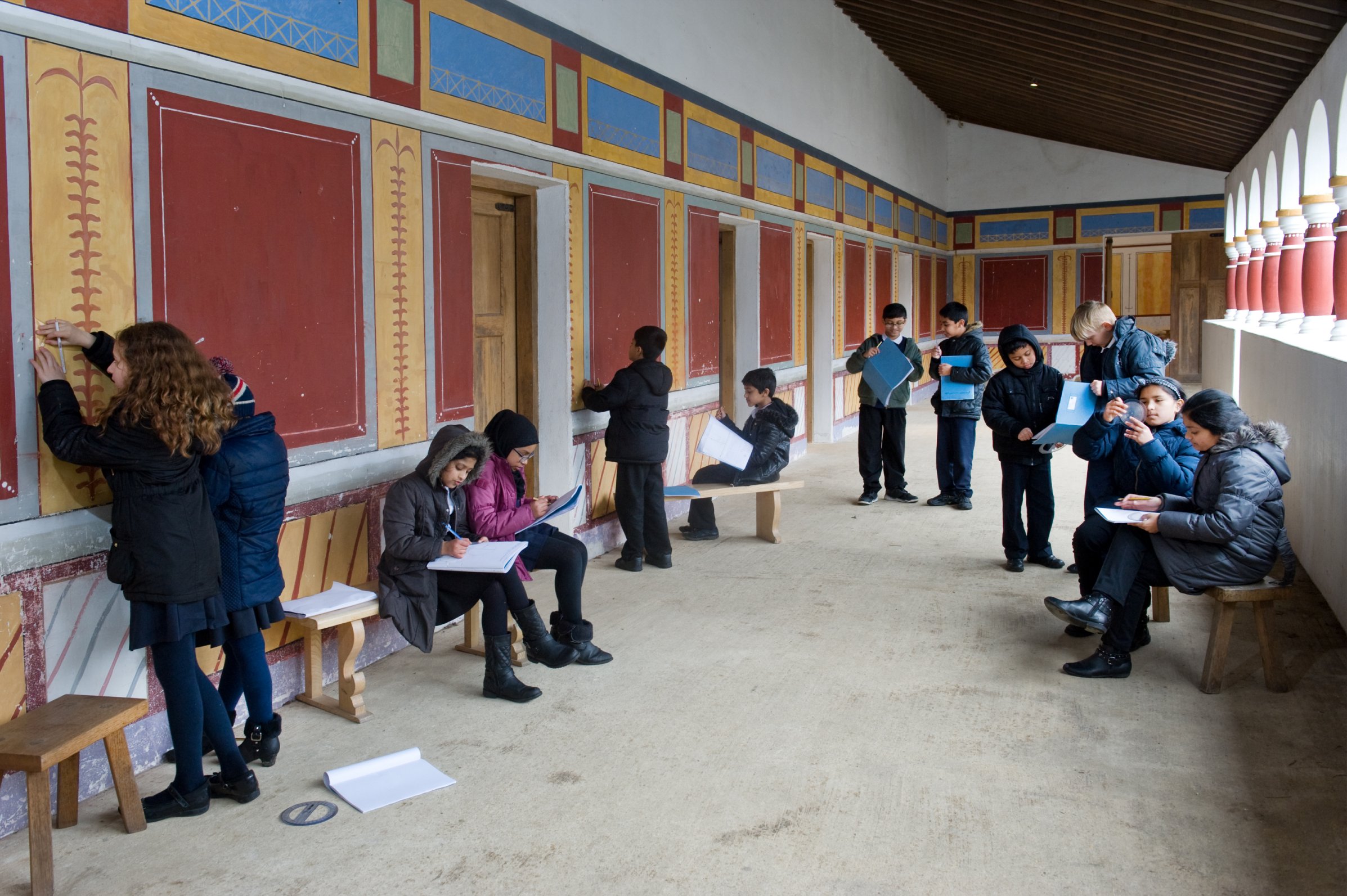
Children from Hadrian Primary School at Arbeia Roman Fort
Photo: Colin Davison
Treasure troves
Is it feasible for primary school children to be based full time in a local museum? Wendy James discusses a pilot project where children benefit from learning in stimulating and beautiful environments.
My favourite places to visit are museums and art galleries, and primary schools. All are treasure troves in my heart and mind, the former housing our national treasures from the past and the latter our very own living treasure for the future.
The idea to ‘combine treasure houses’ came in 2006/07 when I was doing some strategic planning work at a cathedral. I was brought up short by the concern that parents at an associated school had about the lack of computers and indoor sports facilities. It was the most beautiful environment imaginable with acres of outdoor space. Comparisons are odious, but these children had one of the richest and most inspiring surroundings for learning in the country.
The project speaks of citizenship and a sense of place as well as enquiry into the origin, purpose and appreciation of the objects
In that environment they could learn physics, structures, materials, science, geology, art, languages, ecology, biology, sustainability, mathematics, patterns, citizenship, sculpture, even history. Computers are two-a-penny round the corner, and playing games outside is not the worst idea for health and wellbeing.
How children learn
This started some personal study about how children learn. I was drawn to articles on the value of haptic learning and the art of employing visual thinking strategies. There is a lot of research and literature extolling the value of learning through real, concrete objects.
Like many others, I was moved and inspired by the popular contemporary energy and thought in Grayson Perry’s work The Tomb of the Unknown Craftsman at the British Museum, and Edmund de Waal’s concerns at the lack of craft and making teaching in our schools, which he warns could seriously stifle our country’s ability to generate creative thinkers, designers and innovators.
I started to dream of a range of ‘MAKE-ing’ schools (Museums as Knowledgeable Environments).
Meanwhile, we have a perfect storm brewing in the UK: a grave shortage of primary school places, and tremendous pressure in funding for many museums, with several closing with alarming regularity.
Pilot studies
Luckily, I came across the Cultural Institute at King’s College London, based at Tate Modern. With its support we developed the idea to design a series of ’proof of concept’ pilot studies, also involving research staff from the Department of Education and Professional Studies at King’s college. I undertook to hunt down interested museums and local primary schools accordingly. I struck gold and found some truly inspirational partners.
We brought together a group of children from Hadrian Primary School with the Arbeia Roman Fort & Museum in South Shields; a nursery group from Kensington Children’s Centre with Tate Liverpool; and two classes from St Thomas Community Primary School with the National Waterfront Museum in Swansea, which has collections relating to local industrial and social heritage. This great array of subjects speak so much about the neighbourhoods in which the children are growing up.
At Arbeia it was well into the second week before the children truly understood that the Roman fort was real. It isn’t a contemporary construct of what life might have been like. They had a team of archaeologists to engage with on a live site. Their creative writing was transformed and they learned about mosaic design, how materials change when buried below ground, costume, and food and living conditions.
At Tate Liverpool it seemed almost impossible to predict what young children would see and experience in the art. The works expanded their minds, and their language and expression developed immediately. Staff noted the wider perspective of life in a public space (safeguarding clearly paramount). The children created volumes of wonderful material work.
In Swansea the museum speaks so much of place: coal, steel, ships, water, but also Aneurin Bevan and Dylan Thomas. There’s language, social history and daily life, providing a rich social tapestry, and all in Welsh and English.
Wonderful places
Schools are undoubtedly wonderful places as they are filled with the life that the children and staff bring. But they’re empty when the children go home while museum objects are always there.
Museum buildings are often built of good quality fabric. Many could be renovated, remodelled or extended with relative ease. Some personnel skills and resourcing could also be shared, such as administration and facilities staff, teaching support, heat and light, and so on.
Also, very importantly, primary children bring their families with them. They all turn up at some point in the year, giving a museum a potentially captive audience.
I believe in this concept, not as a universal panacea but as an option. It’s a possible new way to think of delivering schools in a local cultural context. With the right guidance in the establishment of such an idea, our children would have rich food to nurture creative thinkers, more solidly rooted in the incredibly diverse cultures that we have.
The project speaks of citizenship and a sense of place, as well as enquiry into the origin, purpose and appreciation of the objects.
Maybe children’s questions could become: “How can we make more treasure in life?” For them to enjoy and mutually benefit from, as well as leave behind for their children and grandchildren to come in the museums of the future.
Wendy James is a partner at Garbers & James, architects specialising in the public cultural sector.
www.garbersjames.com
Join the Discussion
You must be logged in to post a comment.